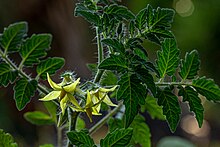| Solanum pimpinellifolium | |
|---|---|

| |
| Scientific classification | |
| Kingdom: | Plantae |
| Clade: | Tracheophytes |
| Clade: | Angiosperms |
| Clade: | Eudicots |
| Clade: | Asterids |
| Order: | Solanales |
| Family: | Solanaceae |
| Genus: | Solanum |
| Species: | S. pimpinellifolium |
| Binomial name | |
| Solanum pimpinellifolium L., 1755 | |
| Synonyms | |
|
Lycopersicon pimpinellifolium (L.) Mill. | |
Solanum pimpinellifolium, commonly known as the currant tomato or pimp, is a wild species of tomato native to Ecuador and Peru but naturalized elsewhere, such as the Galápagos Islands. Its small fruits are edible, and it is commonly grown in gardens as an heirloom tomato, although it is considered to be wild rather than domesticated as is the commonly cultivated tomato species Solanum lycopersicum. Its genome was sequenced in 2012.

Breeding purposes
It will hybridize with common domestic tomatoes. There are annual, biennial, and perennial varieties. Solanum pimpinellifolium is important in tomato breeding.
Its relatedness to tomatoes and ability to freely cross with them has allowed it to be used for the introduction of disease resistance traits in tomato varieties, as well as in the study of the genetic control of tomato traits such as fruit shape and size. It has higher amounts of lycopene, vitamin C, and phenolic acids, as well as a higher antioxidant capacity than Solanum lycopersicum. Its 900 Mb genome differs from the tomato at 0.6% of base pairs; in comparison, they both differ from the potato (from which they diverged 7.3 million years ago) at 8% of bases.
Considered the ancestor of domesticated tomatoes, it is valued for supplementing the limited gene pool of the domestic tomato. Due to agricultural development, the wild currant tomato is becoming less prevalent in the native range of northern Peru and southern Ecuador. In addition, seed collection is hampered by issues with the Convention on Biological Diversity.
References
- "Species Solanum pimpinellifolium (Currant tomato) (Lycopersicon pimpinellifolium)". Uniprot Taxonomy. Retrieved January 28, 2011.
- "Solanum pimpinellifolium". Germplasm Resources Information Network. Agricultural Research Service, United States Department of Agriculture. Retrieved 2010-01-12.
- NRCS. "Solanum pimpinellifolium". PLANTS Database. United States Department of Agriculture (USDA). Retrieved 17 November 2015.
- ^ "Why is This Wild, Pea-Sized Tomato So Important?". Smithsonian Magazine.
- "New nomenclature for lycopersicon". Sol Genomics. Retrieved February 17, 2013., from Spooner, D.M.; Peralta, I.E.; Knapp, S. "AFLP phylogeny of wild tomatoes ". Taxon.
- "Smallest Tomato: The Currant Tomato and other Small Wonders". Tomato Casual. Archived from the original on June 11, 2017. Retrieved February 18, 2013.
- Bai, Y.; Lindhout, P. (2007). "Domestication and breeding of tomatoes: what have we gained and what can we gain in the future?". Annals of Botany. 100 (5): 1085–1094. doi:10.1093/aob/mcm150. PMC 2759208. PMID 17717024.
- ^ The Tomato Genome Consortium (31 May 2012). "The tomato genome sequence provides insights into fleshy fruit evolution". Nature. 485 (7400): 635–641. Bibcode:2012Natur.485..635T. doi:10.1038/nature11119. PMC 3378239. PMID 22660326.
- "Species: Solanum pimpinellifolium". Sol Genomics. Retrieved January 28, 2011.
- ^ "Solanaceae Source, Solanum pimpinellifolium L., Cent. Pl. 1: 8. 1755. Type: Cultivated in Uppsala, Anon. (lectotype, LINN 248.15 [BH neg. 6802], designated by Knapp & Jarvis 1990)". Natural History Museum. Retrieved January 28, 2011.
- Caicedo, AL; Schaal, BA (Jul 2004). "Population structure and phylogeography of Solanum pimpinellifolium inferred from a nuclear gene". Mol Ecol. 13 (7): 1871–82. Bibcode:2004MolEc..13.1871C. doi:10.1111/j.1365-294X.2004.02191.x. PMID 15189210. S2CID 12460436.
- Gürbüz Çolak, Nergiz (March 2020). "Mapping of quantitative trait loci for antioxidant molecules in tomato fruit: Carotenoids, vitamins C and E, glutathione and phenolic acids". Plant Science. 292: 110393. Bibcode:2020PlnSc.29210393G. doi:10.1016/j.plantsci.2019.110393. hdl:11147/8865. PMID 32005398. S2CID 210998191 – via Elsevier Science Direct.
- "Taking Tomatoes Back to Their Tasty Roots". NPR.org.
| Taxon identifiers | |
|---|---|
| Solanum pimpinellifolium |
|
This Solanales article is a stub. You can help Misplaced Pages by expanding it. |